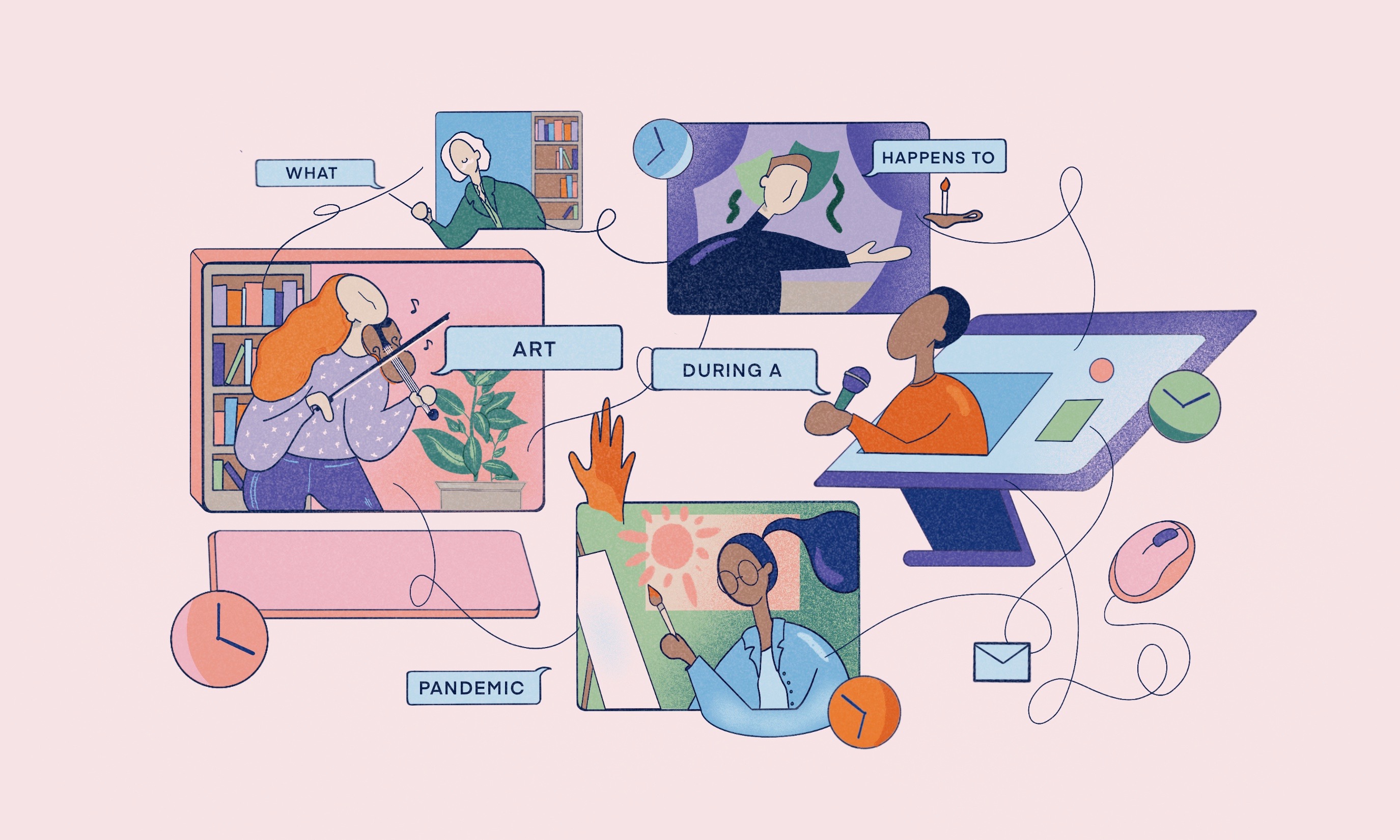Staged in the Devine Studio Theatre sits a completed set for a show that will never go up. A stage begging for performers with light cues programmed at the ready has been abruptly transformed into a ghost town. While the dust collects on the would-be bed and breakfast set in the Performing Arts Center, unpainted wood on unfinished steps opens to risers littered with traces of pre-tech week snacks in Poulton Hall.
On March 12, amidst a week of uncertainty for the entire Georgetown community, students in the Department of the Performing Arts received an email that brought months of effort to a halt. All performances, workshops, and concerts were postponed or canceled in light of COVID-19. Shortly after, students learned that all classes, including acting, drawing, and sculpting classes, would be relegated to the digital medium.
The arts community at Georgetown has been left without a script. With season planning for next year’s productions underway and graduating seniors involved in upended performances, any postponement could spark chaos in the fall for Georgetown’s student-driven theater community. For visual and performing arts classes, key elements of the courses have been stripped away as dancers, painters and actors alike adapt to art in an online world.
The finished set in the Devine that would have housed Nomadic Theatre’s production of John serves as a distant reminder for the questions pressing artists right now. How do you reconcile with months of effort cut short without closure? How do you teach, create, and share art during a pandemic? The responses to this difficult transition have created new communities of Georgetown artists experiencing a profound sense of loss as they redefine their art.
Due to the abrupt adjustment to off-campus learning, many students left their art abandoned on campus. Deborah Han (COL ’23) has experienced this first hand as she navigates her “Painting Studio II” class.
At the center of the “Painting Studio II” course are three large canvas projects. Before spring break, Han and her classmates were all at different stages of their second project when most were suddenly required to move off-campus. While some were able to retrieve their canvases and finish their second project, other artists were not. Han is one of these students.
“Having to leave it off as it is and having to leave it on campus is pretty disheartening,” Han said.
Now, the class meets on Zoom and shares their progress on their third project via joint PowerPoint presentation slides.
The physical medium of painting means students must have access to expensive art materials. Fortunately, the university sent Han two canvasses and all the materials she needed, including a variety of different paints. “I was really thankful and touched that they were willing to send supplies to the students,” Han said.
For performing arts classes, however, the adjustment to online learning has meant the sacrifice of performances and dynamics that come with a physical audience, a central focus of the art form lost in the transition. In acting courses, interactions with your castmates, peers, and audience are key. However, from performing the works of Tennesse Williams over Zoom to filming music videos in drag, young actors have found creative ways to continue their work in the arts.
Lily Cratsley (COL ’23) expected her “Cabaret Performance” class to culminate in a final show in the DPAC lobby with a collection of scenes featuring characters students had developed throughout the semester. Instead, the class will now post a collection of videos of their work online.
Cratsley said she was pleasantly surprised by how the transition went. “I would say my expectations were far exceeded,” she said. “I thought that it wasn’t going to work, that doing improv over Zoom wasn’t going to read how we wanted it to, and I’d say that for the most part it’s actually been super successful.”
An initial requirement of the class was that one of the two characters the students created had to play with gender in some fashion. Now that students were in their homes, Professor Michael Williams had to reevaluate the requirement with his students and their shifting ideological environments in mind.
“There are a lot of complexities to the world of drag that have to deal with sexism and homophobia,” Cratsley said. “Knowing that some of his students were living in much more conservative environments than what Georgeotwn’s DPAC 035 offered, he altered [that requirement].”
Even with the adaptations, there are some aspects of theater and performance that cannot be recreated over Zoom, including laughter and engagement from the audience.
“That has been difficult to transition to, not having laughter to respond to,” Cratsley said. In classes where improvisation is key to developing and fine-tuning characters, the students can no longer feed off the audience as they could in person. “Cabaret performance as a genre is so reliant on the relationship between you and the audience,” Cratsley said.
It’s not just actors who are missing the connections being in person provided their art. Amanda Gao (NHS ’23) has been dancing since she was four years old, but rarely alone. A member of the Georgetown University Dance Club (GUDC), she’s trying to find ways to make the best of the situation, as the club shifts from communal practices to an academic approach to their art. “I want to see this as an opportunity to try something new and explore movement differently,” Gao said.
Fortunately, GUDC’s spring concert occurred prior to the cancellations. Now, the club meets online every week with a new curriculum covering different technical topics and diving into choreographic studies.
While these new conditions for arts education have provided students like Gao a chance to explore dance through critical and academic lenses, the dancers still miss the movement and togetherness that define their art. Student dancers, now without the resources of an on-campus studio or practice room, are confined to dancing and expressing themselves in their homes, if they can. For Gao, dancing on campus was her escape from the stress of school. “Even if I try to dance in my room, it just doesn’t feel the same,” she said.
For some arts groups on campus, faculty support paired with student enthusiasm have led to postponements and reframing of performances. Not without challenges of their own, students still holding rehearsals and performing over Zoom have demonstrated incredible perseverance.
The University Concert Choir and University Orchestra postponed their spring concert, featuring the work of Margaret Bonds, including some lesser-known pieces. With the concert moved to the fall, members of the choir and orchestra are still rehearsing, though mostly on their own. As two ensemble-heavy art forms that pull from the strength of the collective, the transition to solo practices and evaluation has introduced a newly isolated dynamic to the students in the orchestra and choir.
As well as being a visual artist, Han is the Assistant Concertmaster and plays the violin in the orchestra. Members send a video or audio clip of themselves playing their parts on their instruments to their conductor every other week. This is an adjustment for students like Han who are used to being part of a collective. “There’s more pressure,” Han said. “You’re being heard as a soloist as opposed to being heard as part of a rather large ensemble.”
For many, the community aspect of the choir and the orchestra is what drew them to the art form in the first place. “Hands down the best part about playing an instrument is being able to play with other people,” Han said.“It’s sad not being able to have that experience anymore.”
Despite not being able to physically practice together, the choir community has come together over the new online environment. With the technical issues presented by Zoom, traditional rehearsals with everyone singing all together have been canceled. Now, the group practices songs together with their audio on mute since they’re all just a little out of sync.
While the choir’s ability to collectively practice and perform has been diminished due to COVID-19, the choir is still able to maintain their strong, central community.
“These developments have only altered the purpose of the choir in a technical sense, and have left its spirit untouched,” Concert Choir President Felipe Lobo Koerich (SFS ’21) wrote in an email to the Voice. “Fundamentally, the spirit of the choir rests on caring for each other and the music we have elected to perform together.”
While the Margaret Bonds Concert was postponed to the fall, the Department of Performing Arts’ upcoming production of The Rover was “reframed” to a virtual reading of the show. The production, adapted and directed by Director of Theater and Performance Studies Maya Roth, was performed over Zoom and live-streamed on YouTube on April 18.
When Georgetown went on spring break, The Rover had been completely staged, the set was being loaded, and costumes were in progress. Cratsley, in addition to her acting classes this semester, performed as Don Pedro in The Rover. “We were really far along, but that meant that the transition was that much easier because it wasn’t like we had to block anything,” Cratsley said. “We just had to figure out: how does this show that already exists live in a virtual world?”
Through a series of conversations over Zoom with the cast and production team, The Rover (Reframe) was born. Along with the staged reading, a website will be created with videos of sword choreography, photos of set and costume designs, and an art project based on the mask designs from the show.
While reframing the show allowed actors to take a more innovative approach to performance, many aspects of The Rover were lost in the online adaptation. “The saddest thing that we lost in transitioning virtually was the audience interaction,” Cratsley said. Over Zoom, actors had to find new ways to perform asides and create moments with their virtual audience. They also lost key physical aspects of the show, including some songs, dances, and sword fighting.
With all that was lost and adapted, the cast and production team behind The Rover persevered and succeeded in bringing art to the Georgetown community. “I think it was a really important moment for some people, in this struggling time, to reflect and see the arts and see a community of people who are really passionate finding ways to connect with each other during a pandemic,” Cratsley said. “It’s a terrifying time, but we all had three hours of fun and joy and community and art and love and we shared it with other people.”
While faculty-driven arts programs and performances have been able to navigate their projects as the semester took its turn, student theater groups Nomadic Theatre and Mask and Bauble canceled their productions in light of COVID-19.
Nomadic Theatre’s John was set to open March 19 and, with a practically finished set and two more days of tech, was ready to go when the university went on break. Nearly a month from when the show would have closed, director and graduating senior Timmy Sutton (COL ’20) reflected on the importance of process in theater, especially when the process doesn’t end with a product.
“For me, it was really important that we weren’t just putting on a play,” Sutton said. “You shouldn’t build your process around having a great product. You should build your process around having a great process.” So, he and his directing staff utilized community outreach to explore how theater and the central ethic of a show can be used to organize and go out into the community.
To this end, John partnered with the Hypothermia Outreach Team (HOT) on campus. Everyone who worked on the process was required in their contracts to get trained by the team and go on a “HOT walk,” taking supplies to people experiencing homelessness in the Georgetown area on nights where it gets below freezing.
While Sutton was proud of what occurred during the process of the production, a three-hour play with a heavy reliance on the set, setting, silence, and “stuff,” would be too much to perform on Zoom. “Our production of John wasn’t designed to be done over Zoom,” Sutton said.
With the complications of Zoom theater in mind, director of Mask and Bauble’s Legally Blonde Kate Clark (COL ’21) has found a way to give her show its moment.
The production of Legally Blonde was set to open on April 1 and would have been entering the home stretch of pre-production after spring break. “We were so close, and yet there was so much more work that I wanted to do,” Clark said. “I was in disbelief for a pretty long time at first, and then I was just kind of angry because it wasn’t something that I could control in the slightest,” she said.
Clark and the directing staff decided to plan a concert version of Legally Blonde during orientation in the fall. Keeping the cast and production team together was important to the directing staff, so on what would’ve been opening night, the cast and crew had a bittersweet Zoom bonding event where the plans for orientation were announced. “Now that we’ve made a plan to be able to let the show have its moment, that’s really calmed me down,” Clark said. “And it’s not even just that we have that plan, but that people are excited for it and want to do it.”
In all the hope and positivity surrounding the future of Legally Blonde, there is an undeniable sadness in knowing that a complete production of the show will never be performed. This is felt especially by those in the cast not returning to Georgetown in the fall, including the show’s star, Cristin Crowley (MSB ’20). Crowley has performed in seven main stage productions in her time at Georgetown and was most recently cast as protagonist Elle Woods in Legally Blonde. Theater has been her family at Georgetown since the beginning and completed her experience there. “It was that first time that I did a Nomadic show that whatever was missing about my college experience was suddenly there,” Crowley said. “I feel like theater was the missing piece and I have never left since then.”
Crowley remembers her last rehearsal for Legally Blonde vividly. She and her co-star took photos for the banner in Red Square and sang her favorite song in the show, “Legally Blonde,” Elle’s farewell. “Looking back now, it’s crazy. We had no idea that would be our last rehearsal,” Crowley said.
When she received the news that Georgetown was moving to online classes until further notice, Crowley’s first thought was about the show. “The first thing I did was I called my mom and told her to cancel my hair appointment to dye my hair blonde,” she said. “The first thing that was on my mind was Legally Blonde.”
For Crowley, the whole situation is heartbreaking. “Just like how the first time I was cast in a show and found the missing piece, now it’s like something is missing,” Crowley said. “I’ll always look back on Georgetown very fondly, but I’ll always remember that missing piece at the end.”
However, Crowley found a way to maintain good spirits. When the time came for her hair appointment, the one that would’ve made her blonde for a show she wouldn’t get to put on, Crowley decided to still dye her hair. For her, by dying her hair blonde, she feels like she’s Elle. “I still get to be Elle Woods,” she said. “Even though it wasn’t for an audience.”
Han and Sutton are both Voice staff members. Hoge is a member of the University Concert Choir and worked on Legally Blonde.





